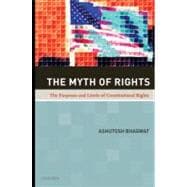
Note: Supplemental materials are not guaranteed with Rental or Used book purchases.
Purchase Benefits
What is included with this book?
| Acknowledgments | p. xi |
| The Myth of Rights: Of Aliens, Corporations, and Guns | p. 1 |
| State Action and Positive Rights | p. 5 |
| The Rights of Corporations and Aliens | p. 10 |
| The Second Amendment | p. 15 |
| The Nature of Rights: A Theoretical and Historical Overview | p. 23 |
| The Popular View of Rights | p. 23 |
| Rights as Trumps | p. 24 |
| Criminal Procedure and Rights as Trumps | p. 25 |
| Other Theories of Rights | p. 26 |
| Rights During the Founding Period: Collective versus Individual Rights | p. 30 |
| Constitutional Rights and the Structure of Government | p. 37 |
| Constitutional Structure and Constitutional Rights | p. 37 |
| The Structural Bill of Rights: A First Look | p. 41 |
| The Civil War and the Revolutionary Fourteenth Amendment | p. 50 |
| How Constitutional Rights Limit Governmental Power | p. 59 |
| Limits on Power | p. 59 |
| Actions and Purposes | p. 64 |
| Illegitimate Purposes | p. 67 |
| Direct Intrusions and Limited Purposes | p. 69 |
| Incidental Burdens and Balancing | p. 73 |
| Democracy, Constitutionalism, and Judicial Legitimacy | p. 75 |
| Free Speech and Self-Governance | p. 79 |
| Theories of Free Speech | p. 79 |
| Self-Governance and Resistance | p. 81 |
| Anti-Orthodoxy: Of Flags, Communists, and Racists | p. 83 |
| The Mass Media: Enhancing Speech Through Regulation | p. 96 |
| Incidental Burdens on Speech and the Speech/Conduct Distinction | p. 105 |
| The Government as Speaker, Employer, and Owner | p. 107 |
| Regulating Private Speech | p. 113 |
| Regulating the Political Process | p. 115 |
| The Religion Clauses: Reconciling Accommodation and Separation | p. 121 |
| Free Exercise and the Question of Mandatory Accommodation | p. 124 |
| The Establishment Clause-Voluntary Accommodation and School Prayer | p. 134 |
| Property Rights and Economic Regulation | p. 151 |
| The Importance of Economic Rights | p. 151 |
| Searches and Seizures | p. 155 |
| The Contracts Clause | p. 156 |
| Takings: The Kelo Case and the Problem of Public Use | p. 160 |
| Regulatory Takings | p. 164 |
| Racial Discrimination and Affirmative Action: The Meaning of Equal Protection | p. 173 |
| Segregation and Racial Discrimination | p. 180 |
| Affirmative Action | p. 190 |
| Discrimination on the Basis of Sex, Sexual Orientation, and Other Characteristics: Translating Equal Protection | p. 205 |
| Sex Discrimination | p. 206 |
| Sexual Orientation | p. 215 |
| Age, Disability, and Other Irrelevant Characteristics | p. 221 |
| The Nontextual Constitution: Privacy and Other Unenumerated Rights | p. 225 |
| The Historic Evolution of the Nontextual Constitution | p. 227 |
| The Death of Natural Law and the Failure of Consensus | p. 240 |
| A Structural Approach to the Unwritten Constitution | p. 245 |
| Evolving Privacy and Due Process | p. 253 |
| Same-Sex Marriage and Abortion | p. 256 |
| Structural Rights and the War on Terror | p. 261 |
| The Problem of Presidential Power-Torture and Wiretapping | p. 269 |
| Enemy Combatants-Yaser Hamdi, Jose Padilla, and Ali Al-Marri | p. 276 |
| Enemy Combatants-Guantanamo Bay | p. 283 |
| Index | p. 289 |
| Table of Contents provided by Ingram. All Rights Reserved. |
The New copy of this book will include any supplemental materials advertised. Please check the title of the book to determine if it should include any access cards, study guides, lab manuals, CDs, etc.
The Used, Rental and eBook copies of this book are not guaranteed to include any supplemental materials. Typically, only the book itself is included. This is true even if the title states it includes any access cards, study guides, lab manuals, CDs, etc.